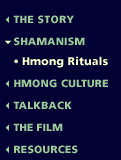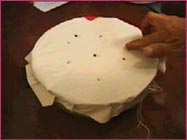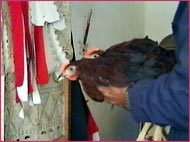 |



|
 |
 |

Soul-Calling
The Hmong religion is traditionally animist (animism is the belief in the spirit world and in the interconnectedness of all living things). At the center of Hmong culture is the Txiv Neeb, the shaman (literally, "father/master of spirits"). According to Hmong cosmology, the human body is the host for a number of souls. The isolation and separation of one or more of these souls from the body can cause disease, depression and death. Curing rites are therefore referred to as "soul-calling rituals". Whether the soul became separated from the body because it was frightened away or kidnapped by an evil force, it must return in order to restore the integrity of life.
 |
Soul-Calling: The Seed Ceremony
In THE SPLIT HORN, shaman Paja Thao is worried that his family is drifting away from Hmong traditions. This causes him concern, so he arranges a special seed ceremony to see if his family's souls have wandered.
 |
The Trance
A shaman is transported to another world via a "flying horse," a wooden bench usually no wider than the human body. The bench acts as a form of transportation to the other world. Buffalo horn tips are thrown to the ground to determine which way the soul has gone. The shaman wears a cloth mask while he or she is reaching a trance state. The mask not only blocks out the real world, so the shaman can concentrate, but also acts as a disguise from evil spirits in the spirit world. During episodes when shamans leap onto the flying horse bench, assistants will often help them to balance. It is believed that if a shaman falls down before his soul returns to his body, he or she will die.

String-Tying
One way in which a shaman returns the soul to the body is through a string-tying ritual. White, red, black or blue strings are tied to shield the person from evil spirits in the form of sickness. These strings signifying the binding up and holding intact of the life-souls.
 |
The String-Tying Ritual
When Paja and his wife became sick and depressed, he asked his aunt, a shaman, to perform a healing ceremony for them. During this ceremony, strings are tied around their wrists to restore their souls to their bodies.
 |

The Hmong Funeral
When a Hmong dies, his or her soul must travel back to every place the person lived until it reaches the burial place of its placenta. Only after the soul is properly dressed in the "placental jacket" can it travel on to be reunited with ancestors and to be reincarnated as the soul of a new baby. The Hmong revere their elders, and believe that anyone who is not accorded the proper funerary rites - being washed, dressed in special clothes, honored with animal sacrifices, verbally guided back to where the placenta is buried, lamented with musical instruments and laid to rest will have a lost, naked and wandering soul. Funeral rituals often last three to four days.
 |
The Chicken Crows:
A Funeral Ritual
During funeral rituals of the Thaos' relative Uncle Por, family members sacrifice a chicken for Por to carry on his journey to find his ancestors.
 |
Animal Sacrifice
Shaman attempt to heal illnesses through offerings to the spirits, such as with meals or with a sacrifice of a chicken, pig, cow or other animal. In Hmong culture, the souls of sacrificial animals are connected to human souls. Therefore a shaman uses an animal's soul to support or protect his patient's soul. Often healing rituals are capped by a communion meal, where everyone attending the ritual partakes of the sacrificed animal who has been prepared into a meal. The event is then ended with the communal sharing of a life that has been sacrificed to mend a lost soul.
|
 |
 |